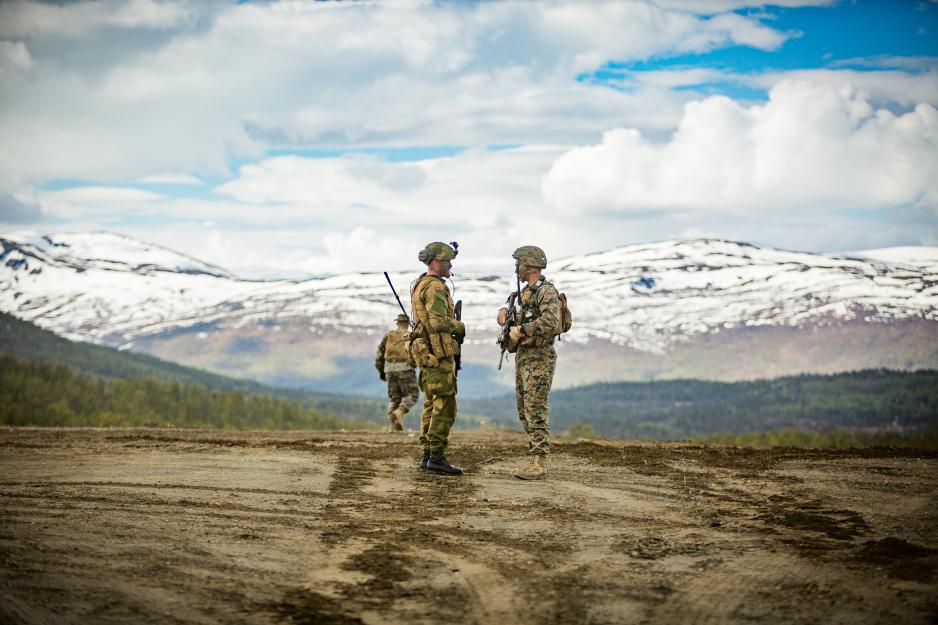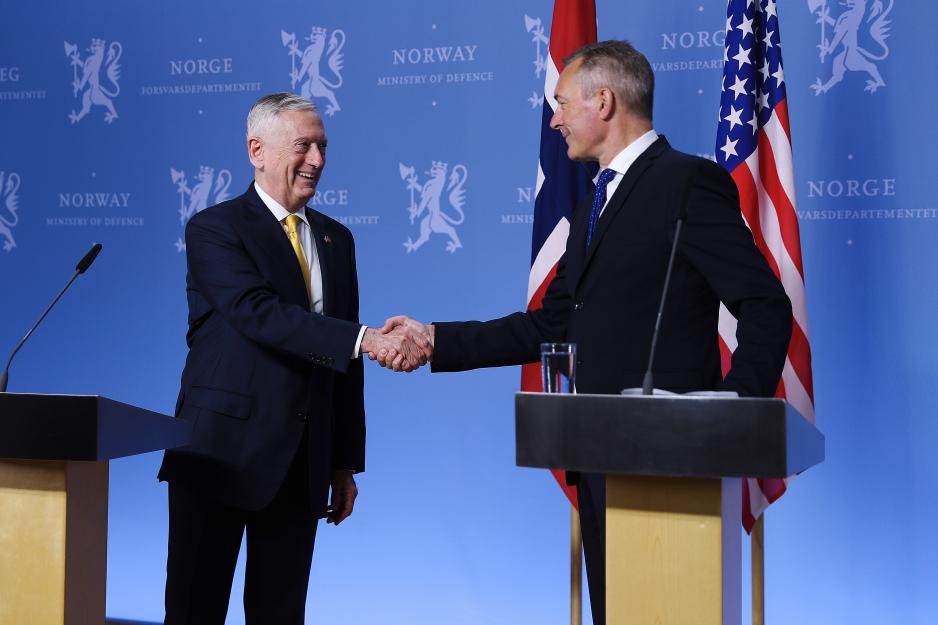USA in the High North - A Lasting Engagement

Norwegian soldier with marine from U.S Marines Corps during exercise Thunder Reindeer. Foto: Frederik Ringnes/Forsvaret.
As a relatively small state with vast ocean areas and bordering on a great power in the north, it is in Norway’s security interest to secure a close and solid relationship with the United States as well as other allies, and to make sure that these understand the Norwegian worries in the north.
The Unites States’ actions are important for Norwegian security policies, which to a large degree include the High North.
The Arctic is Norway’s most important foreign policy priority. Norway has ocean areas six times the land size of the country, and more than half of it is located in the High North.
Ensuring that the US and Nato are present and attentive to the High North areas has been a key element of Norwegian security policy thinking, exemplified in recent years through the Core Area Initiative. This Norwegian security policy initiative was launched by Norway within Nato in 2008, with an aim to contribute to bringing NATO ‘back home’ to its core area after years of being engaged in international operations. However, Norway is left rather alone amongst the organisation's other priorities with its desire for increased Nato focus in the High North.
Just a few miles from the North Norwegian border lies the Russian Northern Fleet. In the surrounding ocean, there are Russian nuclear submarines which are crucial for the Russian defence if land-based installations were to be attacked. Norway is close to the core of the Russian ‘Bastion Defence’.
Last week, it was announced that the US is pulling out approximately three thousand American troops from ‘Cold Response’, a series of bi-annual winter exercises in Northern Norway with allies and partners. According to Norwegian broadcaster NRK, Lieutenant Colonel Ivar Moen, spokesman at the Norwegian Armed Forces Head Quarters, it is the situation in the Middle East and the tense situation between the U.S. and Iran that are the causes for the U.S. pulling its soldiers from the exercise.
As Norway’s most important ally and the core of Nato, the United States’ strategic priorities are important for Norwegian security. Uncertainty and unpredictability with regard to US policies and position, which follow from situations such as the one between the US and Iran, are not without importance to Norway - even though Norway, geographically speaking, islocated far from the situation longer south.
The United States and the High North
Andreas Østhagen is a researcher at the Fridtjof Nansen Institute. Thursday, he spoke at a Oslo seminar on great power politics in the Arctic about the US and Trump in the Arctic.
Asked if the Unites States seems to draw its attention away from the Arctic, Østhagen says to High North News that USA, as a great power, has its attention on many places in the world and is a part of the game in many locations. Just because the focus is on other places right now does not mean that the focus will disappear from the Arctic.
The engagement we have seen from the U.S. in the Arctic recently is focused on our part, the High North and the North Atlantic. Everything from Keflavik to Greenland and Jan Mayen.
While we see a US administration that conducts a policy characterized by a bit of ‘back and forth’, there has at the same time been an increasing focus on the High North from the very same administration, and particularly towards the European parts of the Arctic and the North Atlantic, Østhagen points out.
- To the US, the Arctic means different things. The Arctic is not just one dimension. The American Arctic requires a certain attention in the US. However, the engagement we have seen from the US recently in the Arctic is focused on our side, the High North, and the North Atlantic. Everything from Keflavik to Greenland to Jan Mayen.
Throughout the Cold War, the Arctic was a strategic arena for the superpowers. The region has constantly figured in the USA’s global strategy, though focus areas have shifted between various administrations. While the Obama administration mainly had an economic and environmentally-oriented focus towards the region, the Arctic increasingly appears to play into a military and strategic dimension under the Trump administration.
- Under the present American administration, there has been increasing military focus towards the European part of the Arctic. The US’ Second Fleet has been reactivated and the US participates in exercises and capacity building in our High North areas. It would be very strange if the rhetoric that we hear from the White House, and the rhetorical escalation, were to suddenly shift.
- The focus towards the European High North and statements about both Russia and China in the region suggest that the US particularly sees the European part of the region in a greater strategic context. Statements from the current administration suggest that the US sees the region as a potential arena for conflict. US Secretary of State Mike Pompeo’s speech at the Arctic Council Ministerial meeting last year, where he made harsh statements about China and Russia, plays into a greater American strategy of countering China and Russia’s position globally.
Also read
Security policy balance: Norway between the great powers in the north
To Norway, it matters where the U.S. directs its attention.
In addition, what kind of attention and how much attention also has implications.
Even though close trans-Atlantic relations and American presence and focus towards Norwegian core areas are a key aspect in Norway’s security policy thinking, Norway has also balanced its security policy between allied presence and its Nato membership on the one side, with good neighborly relations with Russia on the other.

Norwegian Minister of Defence Frank Bakke-Jensen and United States Secretary of Defence James N. Mattis during a press statement at the Norwegian Ministry of Defence 145th July 2018. Foto: Torbjørn Kjosvold/Forsvaret.
Østhagen notes that from the Norwegian side, it has been a goal to increase presence and attention from allies, including and specially from the United States, both before and after 2014. However, too much presence and attention that could escalate the situation with regards to Russia, can also be difficult for Norwegian authorities.
- Norway finds itself in a lasting balancing act towards Russia. Vi can not underestimate that tension and the need for that balance. However, it does not mean that the US does not have to be engaged in our core areas, but rather that they have to do it in compliance with our interests.
In the immediate future it is unlikely that we will be dependent on any other than Nato, but Nato does not necessarily only mean the United States.
- We have to make sure other allies are engaged and concerned with the region. Canada, for example, participated with a fairly large number of soldiers in the Trident Juncture military exercise in 2018.
Østhagen further notes that we need to have exercises and allies that can support us.
- In this, the United States is the best, for better or worse. Russia is our neighbor, but a much more powerful neighbor than Norway. We have to deal with the insecurity we feel when Russia conducts military activity right off our coast. We cannot be too passive. There is no right answer here, and the debate about deterrence and reassurance is an important debate and a debate we need to have.
Uncertainty around U.S. foreign policy
The Norwegian Institute for Defence Studies’ (IFS) Insight 11-12/2019 “Threats – concepts – resources – the Alliance” contains reflections on the new long-term plan for the defence sector 2021-2024, which will be published this year. It notes that the threat perception is changing with a more assertive Russia, uncertainty around the US' course and our security policy foundation, and that Norway thus must take greater responsibility for its own security.
Gjermund Forfang Rongved, Senior Researcher at the Norwegian Institute for Defence Studies, further notes in Insight 11-12/2019:
“The USA has, under the current presidency of Trump, started a movement towards isolationism related to the “America First” policy and demonstrated a remarkable wobbly course in world politics – lastly with the sudden withdrawal in Syria, where former allied Kurds where let down.”
“Where USA after the WW2 has been a guarantor for a liberal world order based on multilateral agreements, cooperation and reliance on international organizations, and order before power, the US' new course is contributing to undermining this world order, which has particularly been important for small states’ security”, Rongved writes.




